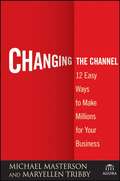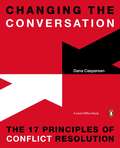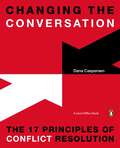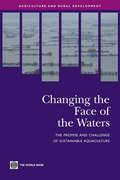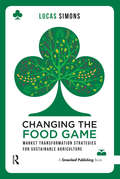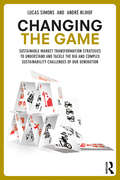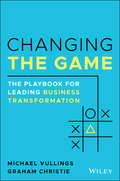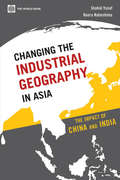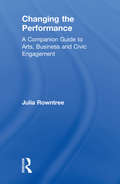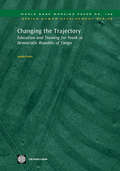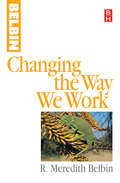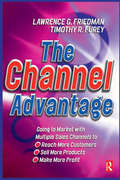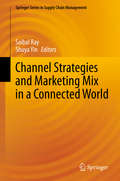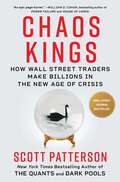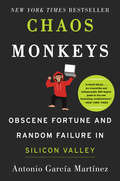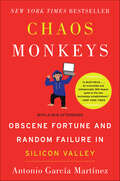- Table View
- List View
Changing the Channel
by Maryellen Tribby Michael MastersonAn all-encompassing guide to making the most from multi-channel marketingWritten in a straightforward and accessible style, Changing the Channel offers you a detailed look at twelve of today's most important marketing channels-explaining how each one works individually as well as in conjunction with each other, leveraging the power of your message for explosive profits.Page by page, you'll become familiar with a variety of approaches, including direct online marketing, social media, public relations, radio and television advertising, direct space ads, event marketing, telesales, telemarketing, joint ventures, affiliate marketing, and direct mail.Discusses how to create successful marketing campaigns by using a mix of different marketing channelsOffers some smart ways to track customer buying habits with a database that covers all marketing channelsHelps you learn how to develop profitable relationships with your customers through frequent contact and by providing free quality content-not just sales pitchesWith this book as your guide, you'll quickly discover how marketing across multiple channels can help develop quality customer relationships and improve the bottom line of your business.
Changing the Conversation: The 17 Principles of Conflict Resolution
by Joost Elffers Dana CaspersenThe seventeen key principles for transforming conflict—in a beautiful package from the creator of The 48 Laws of Power From Joost Elffers, the packaging genius behind the huge New York Times bestsellers The 48 Laws of Power, The 33 Strategies of War, and The Art of Seduction, comes this invaluable manual that teaches seventeen fundamentals for turning any conflict into an opportunity for growth. Beautifully packaged in a graphic, two-color format, Changing the Conversation is written by conflict expert Dana Caspersen and is filled with real-life examples, spot-on advice, and easy-to-grasp exercises that demonstrate transformative ways to break out of destructive patterns, to create useful dialogue in difficult situations, and to find long-lasting solutions for conflicts. Sure to claim its place next to Getting to Yes, this guide will be a go-to resource for resolving conflicts.
Changing the Conversation: The 17 Principles of Conflict Resolution
by Dana CaspersenThe seventeen key principles for transforming conflict—in a beautiful package from the creator of The 48 Laws of PowerFrom Joost Elffers, the packaging genius behind the huge New York Times bestsellers The 48 Laws of Power, The 33 Strategies of War, and The Art of Seduction, comes this invaluable manual that teaches seventeen fundamentals for turning any conflict into an opportunity for growth. Beautifully packaged in a graphic, two-color format, Changing the Conversation is written by conflict expert Dana Caspersen and is filled with real-life examples, spot-on advice, and easy-to-grasp exercises that demonstrate transformative ways to break out of destructive patterns, to create useful dialogue in difficult situations, and to find long-lasting solutions for conflicts. Sure to claim its place next to Getting to Yes, this guide will be a go-to resource for resolving conflicts.
Changing the Corporate DNA: A Step-by-Step Approach to Developing Sense-and-Respond Capabilities
by Stephan H. HaeckelA shift from the make-and-sell to the sense-and-respond business model encompasses a true transformation because it involves changing a firm's basic function from making offers to responding to customer requests, and also changing its structure from that of an efficient machine to that of an adaptive social system. The larger the organization, the more complex the transformation challenge will be, but given the pervasiveness of unpredictability, the survival of organizations will depend on meeting this challenge. This chapter explores the question of how to get there from here.
Changing the Culture at British Airways
by John P. Kotter James K. LeaheyIn just 10 years, 1980-1990, British Airways turned around both its declining image and financial situation. Focusing on the paramount importance of customer service, British Airways went from "bloody awful" to "bloody awesome." Experiencing a financial crisis in 1981 and trying to meet the challenges of privatization helped the people at British Airways focus on changing their culture through reorganization and instituting new beliefs.
Changing the Face of the Waters: The Promise and Challenge of Sustainable Aquaculture
by World BankAquaculture--the farming of fish and aquatic plants--has become the world's fastest-growing food production sector, even as the amount of wild fish caught in our seas and fresh waters declines. From fish foods and pharmaceuticals to management of entire aquatic ecosystems, acquaculture is truly changing the face of the waters. Increased growth, however, brings increased risk, and aquaculture now lies at a crossroads. One direction points toward the giant strides in productivity, industry concentration, and product diversification. Another direction points toward the dangers of environmental degradation and the marginalization of small fish farmers. Yet another direction invites aquaculture to champion the poor and provide vital environmental services to stressed aquatic environments. 'Changing the Face of the Waters' offers a cutting-edge analysis of the critical challenges facing aquaculture, balancing aquaculture's role in economic growth with the need for sound management of natural resources. The book also provides guidance on sustainable aquaculture by evaluating alternative development pathways, placing particular emphasis on the application of lessons from Asia to Sub-Saharan Africa and Latin America. Aimed at policy makers, planners, and scientists, this book provides a comprehensive frame of reference for orienting ideas and initiatives in this dynamic industry.
Changing the Food Game: Market Transformation Strategies for Sustainable Agriculture
by Lucas SimonsBy 2050, the world’s population is estimated to grow to 10 billion. To feed everyone, we will have to double our food production, to produce more food in the next 40 years than in the whole of the last 6,000. Changing the Food Game shows how our unsustainable food production system cannot support this growth. In this prescient book, Lucas Simons argues that the biggest challenge for our generation can only be solved by effective market transformation to achieve sustainable agriculture and food production. Lucas Simons explains clearly how we have created a production and trading system that is inherently unsustainable. But he also demonstrates that we have reason to be hopeful – from a sustainability race in the cocoa industry to examples of market transformation taking place in palm oil, timber, and sugarcane production. He also poses the question: where next? Provocative and eye-opening, Changing the Food Game uncovers the real story of how our food makes it on to our plates and presents a game-changing solution to revolutionize the industry.
Changing the Game: Sustainable Market Transformation Strategies to Understand and Tackle the Big and Complex Sustainability Challenges of Our Generation
by Lucas Simons Andre NijhofWe are at the beginning of the sustainability era. The biggest challenge of our generation is to reach the Sustainable Development Goals. For this we must be willing to understand and change the root causes that create these challenges in the first place. The system itself needs to change. But how to do that? This ground-breaking book Changing the Game reveals the missing insights and strategies to actually achieve system change. The authors Lucas Simons and André Nijhof bring decades of real life and academic experience, and state that most of the sustainability challenges are actually caused by the same system failures, every time. Therefore, the way to accelerate and manage system change is also similar every time – if you know where to look and how to act. The theory of sustainable market transformation and system change is described in a compelling and easy to understand eight-step approach applied to eight different sectors. The authors, together with respected sector experts, describe the drivers, triggers and dominant thinking in each of these sectors as well as the strategies needed to move towards higher levels of sustainability. This book is highly accessible and engaging, and is perfect for use by professionals, leaders and students for understanding how to move markets to a more sustainable future.
Changing the Game: The Playbook for Leading Business Transformation
by Michael Vullings Graham ChristieThe Complete and Comprehensive Guide to Business Transformation As digital technologies and consumer expectations continue to disrupt almost every industry sector, companies are placing greater emphasis on developing and implementing transformation programs. Changing the Game offers the practical knowledge required to create a dramatic step-change in company performance. Designed for executives and managers responsible for a transformation in any type of company and situation, this comprehensive real-world playbook covers the change process from start to finish — from assessing the situation and determining strategic priorities, to developing a roadmap, establishing the governance structure, managing initiative delivery, and evaluating the impact of the transformation. Adopting a robust and pragmatic approach to every stage of business transformation, this authoritative volume explains where to start, identifies key areas of focus, and describes the strategies, decisions, and actions necessary for achieving results. Throughout the text, case studies of leading organizations highlight essential tools and approaches, examine key challenges, and evaluate their impact. A wealth of practical tools help readers build a foundation for change in their organization, define a clear path forward, mobilize teams, assign responsibilities, execute initiatives, track progress, sustain momentum, and more. Provides detailed guidance on envisioning, designing, managing, and delivering a successful company, function or team transformation Enables readers to create a dramatic change in company performance with a results-focused approach based on leading management practices Contains more than 20 in-depth sections representing the entire transformation journey Includes numerous ready-to-use tools and templates, including 50 exhibits, that can be adopted in any organization to accelerate results Features tips and advice from top-level executives at leading companies and government organizations Changing the Game: The Playbook for Leading Business Transformation is an invaluable step-by-step blueprint for executives, managers, teams, and consultants involved in devising and executing transformation programs.
Changing the Industrial Geography in Asia: The Impact of China and India
by Shahid Yusuf Kaoru NabeshimaA great burst of globalization brought the 20th century to a close, creating upheaval in the world economy from roughly 1995 to 2008. And now a second upheaval is in the offing following the severe financial crisis that plunged the global economy into recession in 2008-09. The first upheaval witnessed a massive migration of manufacturing and certain business services that transformed Asia into the industrial heartland of the world. The second upheaval will likely consolidate Asia's industrial preeminence and could result in a concentration of industrial activities in the two most populous and fastest-growing Asian economies -- China and India. As the two Asian giants become the industrial equals of the United States, Germany, and Japan, the ramifications will affect trade and growth worldwide, the future of development in China and India, and industrialization throughout Asia. This book examines these developments, focusing specifically on China and India. Its analysis and conclusions will be of particular interest to policy makers and academics, as well as anyone with an interest in how China and India are likely to reshape industry throughout Asia.
Changing the Performance: A Companion Guide to Arts, Business and Civic Engagement
by Julia RowntreeA result of many years of research and practice, Changing the Performance is a book about the arts and about business, and the interplay between the two. Julia Rowntree gives a fascinating account of her experiences forging the business sponsorship campaign at the London International Festival of Theatre (LIFT). Raising intriguing questions, this book proposes that fundraising for the arts is much more than simply a function for generating income. It fulfils an ancient social role of connection across levels of power, expertise, culture, gender and generation. Rowntree describes why these dynamics are vital to society's ability to adapt. Changing the Performance is an inspiring manual for arts practitioners concerned with the relationship between business, the arts and wider society, and particularly those engaged in fundraising.
Changing the Role of Top Management: Beyond Strategy to Purpose
by Christopher A. Bartlett Sumantra GhoshalStructure follows strategy; and systems support structure. In the high-growth environment of post-World War II, a management doctrine rose up around these two aphorisms. But today the business environment has changed. A change in management doctrine is needed to match this new landscape. After 5 years researching 20 leading European, U.S., and Japanese companies, the authors concluded that senior managers must change their own priorities and way of thinking. Beyond designing corporate strategy, they must shape a shared institutional purpose. They must expand their focus from devising formal structures to developing organizational processes. And more than just managing systems, they must develop people. Top management's role in the companies researched already reflects the changes the authors prescribe. Consequently, 3M has managed to retain an entrepreneurial spirit despite its $14 billion bulk. ABB transformed two "also-ran" companies into the leading competitors in the global power-equipment industry. And companies like AT&T, Royal Dutch/Shell, Intel, Andersen Consulting, Kao, and Corning are doing well despite what some predicted as the inevitable decline of large corporations.
Changing the System: Leading Sustainable and Scalable Change
by John Elkington Pamela HartiganIn addition to science and technology, today's social entrepreneurs are exploring new approaches to governance, property rights, and market transformations. In this chapter, the authors look at some of the ways in which these entrepreneurs are working to change the system and suggest that mainstream companies that follow their lead have an opportunity to shape future market rules and get a jump on competitors.
Changing the Trajectory: Education and Training for Youth in Democratic Republic of Congo
by Sajitha BashirThe Democratic Republic of Congo faces the challenge of providing universal primary education and expanding opportunities for post-secondary education and training for its youth, ages 12 to 24. This study analyzes the current educational attainment and school enrollment status of youth, as well as the formal and informal post-secondary educational and training opportunities available to them. The study uses the results of a simulation model that incorporates enrollment in alternative education programs and considers alternative scenarios for developing the post-primary sector. Each scenario is evaluated for the impact on the human capital accumulation of young people and the sustainability of public expenditures. The report offers policy options for rapidly raising the educational attainment of young people who will be entering the labor force in the next two decades, including expanding opportunities for alternative education and training for out-of-school children, the extension of primary education, and the reorganization of secondary and technical/vocational training to reduce early specialization.
Changing the Way We Change
by Mark Millemann Linda Gioja Richard Tanner PascaleCompanies achieve real agility only when every function and process--when every person--is able and eager to rise to every challenge. This type and degree of fundamental change, commonly called revitalization or transformation, is what many companies seek but rarely achieve because they have never before identified the factors that produce sustained transformational change. The authors identify three interventions that will restore companies to vital agility and then keep them in good health: incorporating employees fully into the principal business challenges facing the company; leading the organization in a different way in order to sharpen and maintain incorporation and constructive stress; and instilling mental disciplines that will make people behave differently and then help them sustain their new behavior. The authors discovered these basic sources of revitalization by tracking the change efforts of Sears, Roebuck and Co., Royal Dutch Shell, and the United States Army. This article is one of the first practical revitalization guides to appear anywhere, and it is based not on theory but on actual experience.
Changing the Way We Work
by R Meredith BelbinHow many problems at work arise from the way in which jobs are set up? Either people don't have a clear understanding of their duties and responsibilities, spending time and energy disentangling them from those of their co-workers or they are hemmed in by job specifications that allow no room for movement and initiative.An alternative system is needed, where jobs can grow and develop: where communication about the work can flow up as easily as down. Dr Belbin describes a radical approach incorporating colour-coding and information technology derived from experiments now being undertaken in three countries. Workset is a new means of delivering greater efficiency in a dynamic process that equally involves managers and jobholders. Dr R. Meredith Belbin, regarded as the father of team-role theory for his widely-read Management Teams: Why they succeed or fail and its successor Team Roles at Work, obtained his first and higher degree at Cambridge University. Later, in a research, lecturing or consulting capacity, he has visited and worked in many countries. In 1988 he founded Belbin Associates which produces Interplace, a computer-based Human Resource Management System, now used world-wide.
Changing to Win: An Incredible Story of Courage and a Template for Success
by Giles LongIn CHANGING TO WIN, Giles Long MBE, eight times Paralympic Gold medal winner, world record breaker, and cancer survivor, shares his revolutionary model for success. His innovative CHIMO cycle method, based on the principles he has followed throughout his life, reveals how a careful balance of motivation and inspiration can lead to extraordinary changes in performance and accomplishments, both on an individual and team level. Illustrated by the author's own incredible tale of courage, perseverance, and Paralympic glory, and drawing on his experience as a successful motivational speaker, CHANGING TO WIN provides a template for achievement in life and in the workplace.
Channel Advantage, The: Going To Market With Multiple Sales Channels To Reach More Customers, Sell More Products, Make More Profit
by Lawrence Friedman Tim Furey'The Channel Advantage' deals with one topic, and deals with it comprehensively and rigorously: how to construct a sales channel system that will yield world-class sales performance and durable competitive advantage. This book helps readers move decisively away from the notion of channel strategy as a sideline to the core business. Building a channel advantage is the core business today, and this is an essential text and reference for all serious marketing and sales professionals and students. Channel innovation is separating market winners from market losers, and not just in leading-edge technology industries. In a business world where industry players are selling practically the same products at essentially the same prices at about the same cost, the only real source of sustainable competitive advantage is the sales channel: how you sell, not what you sell. Selling becomes a question of how to connect products with customers via the best mix of sales channels: the sales force, value-added partners, distributors, retail stores, telemarketing, and the Internet. In short, how companies sell has become as important as what they sell. 'The Channel Advantage' explains how leading companies develop strategies that integrate e-commerce, telemarketing, sales forces, and distributors to achieve superior sales performance and sustainable competitive advantage.Timothy R. Furey is chairman, CEO and co-founder of Oxford Associates, a privately held consulting firm specializing in sales and market strategy, e-commerce channel integration and market research, based in Bethesda, Maryland. Oxford has achieved an annual growth of more than forty percent since its creation in 1991 and was named one of America's 500 fastest growing private companies by Inc. Magazine in 1997. Furey, a pioneer in the use of hybrid sales and marketing strategies for blue chip companies, works extensively with senior management leadership teams to develop and implement go-to-market growth strategies. His clients include IBM, American Express, Marriott, Xerox, Fidelity Investments, Bristol-Myers Squibb, and Johnson & Johnson. Under his leadership, Oxford Associates has developed leading-edge strategies, business processes and systems for deploying and integrating multi-channel sales and marketing systems. They work to align products with the right customers via an appropriate mix of the Internet, telesales, distributors, value-added partners, and traditional sales force channels.Mr. Furey is the co-author of THE CHANNEL ADVANTAGE (Butterworth-Heinemann, August 31, 1999), which is endorsed by the CEOs of America Online, Lotus Development, Ocean Spray, and Xerox. Mr. Furey also serves on the Board of Directors of Alpha Industries (Nasdaq:AHAA), a leading semiconductor manufacturer for wireless telephone applications.Previously, Mr. Furey worked with Boston Consulting Group, Strategic Planning Associates, Kaiser Associates and the Marketing Science Institute. He earned a BA in Economics, cum laude, from Harvard University and an MBA from the Harvard Business School. Lawrence G. Friedman is an internationally recognized channel strategy consultant whose clients have included companies such as Lotus, AT&T, Canon, Compaq Digital Equipment, Microsoft and Bell Atlantic. He also held executive level positions at Andersen Consulting and Huthwaite, Inc., the sales research firm that developed the SPIN Selling Model.In 1996, Friedman, with Neil Rackham and Richard Ruff, co-authored the best-seller, GETTING PARTNERING RIGHT (McGraw-Hill). He is on the review board of the Journal of Selling and Major Account Management, which published his article, Multiple Channel Sales Strategy, in the April, 1999 issue.His firm, The Sales Strategy Institute, works with clients to identify and evaluate new go-to-market opportunities and conduct
Channel Management
by Frank V. CespedesWritten as an introduction to a module concerning channel management for the second-year MBA elective in Marketing Implementation. Discusses: 1) reasons for the growth of multichannel systems in marketing efforts, 2) key components and choices in channel management, 3) major factors that affect producer-reseller relations, and 4) a framework for analyzing common trade-offs between control and resources in most distribution systems.
Channel Strategies and Marketing Mix in a Connected World (Springer Series in Supply Chain Management #9)
by Saibal Ray Shuya YinThis book aims to revisit the “traditional” interaction between channel strategies and the marketing mix in a connected world. In particular, it focuses on the following four dimensions in this context: Consumers, Products, Value Proposition and Sustainability. Keeping in mind the growing digitalization of business processes in the retail world and the move towards omni-channel retailing, the book introduces the state-of-the-art academic and practitioner studies along these dimensions that could enhance the understanding of the potential impact that new technologies and strategies can have on practice in the near future. When launching a new product/service to market, firms usually consider various components of the marketing mix to influence consumers’ purchase behaviors, such as product design, convenience, value proposition, promotions, sustainability initiatives, etc. This mix varies depending on the specific channel and consumer niche that the firm is targeting. But this book shows how channel strategy also influences the effectiveness in utilizing the marketing mix to attract potential customers.
Channelling Mobilities
by Valeska HuberThe history of globalisation is usually told as a history of shortening distances and acceleration of the flows of people, goods and ideas. Channelling Mobilities refines this picture by looking at a wide variety of mobile people passing through the region of the Suez Canal, a global shortcut opened in 1869. As an empirical contribution to global history, the book asks how the passage between Europe and Asia and Africa was perceived, staged and controlled from the opening of the Canal to the First World War, arguing that this period was neither an era of unhampered acceleration, nor one of hardening borders and increasing controls. Instead, it was characterised by the channelling of mobilities through the differentiation, regulation and bureaucratisation of movement. Telling the stories of tourists, troops, workers, pilgrims, stowaways, caravans, dhow skippers and others, the book reveals the complicated entanglements of empires, internationalist initiatives and private companies.
Chants Democratic: New York City and the Rise of the American Working Class, 1788-1850 (20th Anniversary Edition)
by Sean WilentzSince its publication in 1984,Chants Democratic has endured as a classic narrative on labor and the rise of American democracy. In it, Sean Wilentz explores the dramatic social and intellectual changes that accompanied early industrialization in New York. He provides a panoramic chronicle of New York City's labor strife, social movements, and political turmoil in the eras of Thomas Jefferson and Andrew Jackson. Twenty years after its initial publication, Wilentz has added a new preface that takes stock of his own thinking, then and now, about New York City and the rise of the American working class.
Chaos Kings: How Wall Street Traders Make Billions in the New Age of Crisis
by Scott PattersonWritten by a veteran Wall Street Journal reporter, this is a fascinating deep dive into the world of billion-dollar traders and high-stakes crisis predictors who strive to turn extreme events into financial windfalls. There&’s no doubt that our world has gotten more extreme. Pandemics, climate change, superpower rivalries, cyberattacks, political radicalization—virtually, everywhere we look there is mayhem bearing down on us, putting trillions of assets at risk. And at least two factions have formed around how to respond. In Chaos Kings, Scott Patterson depicts how one faction, led by Nassim Nicholas Taleb, bestselling author of The Black Swan, believes humans can never see the big disaster coming. In their view, extreme events—so-called Black Swans—while inevitable, will always catch us by surprise. In 2007, Taleb&’s longtime collaborator, Mark Spitznagel, launched the Universa hedge fund, which would go on to make billions protecting investors against unforeseen chaos in the market. A second faction, which relies on complex formulas, believes looming chaos can be detected. Chief among these risk prognosticators is Didier Sornette, a colorful French mathematician who enjoys riding his motorcycle at speeds in excess of 170 miles per hour. When Sornette looks out from what he calls his Financial Crisis Observatory in Zurich, Switzerland, what he sees are Dragon Kings—punishing events that are unlikely to occur but have probabilities that can be predicted…and defended against. Which faction is right? All of our financial futures may depend on the answer.
Chaos Monkeys: Obscene Fortune and Random Failure in Silicon Valley
by Antonio Garcia Martinez<P>Liar's Poker meets The Social Network in an irreverent exposé of life inside the tech bubble, from industry provocateur Antonio García Martínez, a former Twitter advisor, Facebook product manager and startup founder/CEO. <P>The reality is, Silicon Valley capitalism is very simple:Investors are people with more money than time.Employees are people with more time than money.Entrepreneurs are the seductive go-between.Marketing is like sex: only losers pay for it. Imagine a chimpanzee rampaging through a datacenter powering everything from Google to Facebook. Infrastructure engineers use a software version of this "chaos monkey" to test online services' robustness--their ability to survive random failure and correct mistakes before they actually occur. Tech entrepreneurs are society's chaos monkeys, disruptors testing and transforming every aspect of our lives, from transportation (Uber) and lodging (AirBnB) to television (Netflix) and dating (Tinder). One of Silicon Valley's most audacious chaos monkeys is Antonio García Martínez. <P>After stints on Wall Street and as CEO of his own startup, García Martínez joined Facebook's nascent advertising team, turning its users' data into profit for COO Sheryl Sandberg and chairman and CEO Mark "Zuck" Zuckerberg. Forced out in the wake of an internal product war over the future of the company's monetization strategy, García Martínez eventually landed at rival Twitter. He also fathered two children with a woman he barely knew, committed lewd acts and brewed illegal beer on the Facebook campus (accidentally flooding Zuckerberg's desk), lived on a sailboat, raced sport cars on the 101, and enthusiastically pursued the life of an overpaid Silicon Valley wastrel. <P>Now, this gleeful contrarian unravels the chaotic evolution of social media and online marketing and reveals how it is invading our lives and shaping our future. Weighing in on everything from startups and credit derivatives to Big Brother and data tracking, social media monetization and digital "privacy," García Martínez shares his scathing observations and outrageous antics, taking us on a humorous, subversive tour of the fascinatingly insular tech industry. <P>Chaos Monkeys lays bare the hijinks, trade secrets, and power plays of the visionaries, grunts, sociopaths, opportunists, accidental tourists, and money cowboys who are revolutionizing our world. The question is, will we survive? <P><b>A New York Times Bestseller</b>
Chaos Monkeys: Obscene Fortune and Random Failure in Silicon Valley
by Antonio Garcia MartinezThe instant New York Times bestseller, now available in paperback and featuring a new afterword from the author—the insider's guide to the Facebook/Cambridge Analytica scandal, the inner workings of the tech world, and who really runs Silicon Valley“Incisive.... The most fun business book I have read this year.... Clearly there will be people who hate this book — which is probably one of the things that makes it such a great read.”— Andrew Ross Sorkin, New York TimesImagine a chimpanzee rampaging through a datacenter powering everything from Google to Facebook. Infrastructure engineers use a software version of this “chaos monkey” to test online services’ robustness—their ability to survive random failure and correct mistakes before they actually occur. Tech entrepreneurs are society’s chaos monkeys. One of Silicon Valley’s most audacious chaos monkeys is Antonio García Martínez.After stints on Wall Street and as CEO of his own startup, García Martínez joined Facebook’s nascent advertising team. Forced out in the wake of an internal product war over the future of the company’s monetization strategy, García Martínez eventually landed at rival Twitter. In Chaos Monkeys, this gleeful contrarian unravels the chaotic evolution of social media and online marketing and reveals how it is invading our lives and shaping our future.
